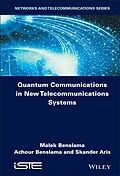Quantum Communications in New Telecommunications Systems
Computers are quickly making the transition from silicon towards miniaturization, which now risks reaching its limits as dictated by the laws of physics. Quantum communications are the answer to post-silicon computers.
The main applications for quantum communications in the domain of telecommunications are beginning to appear, with some commercial applications already on the market.
This book explores the technological advances in quantum communications with a special focus on telecommunications systems.
The authors provide a comprehensive state of the art on quantum communications and quantum signal processing. The reader will learn about the advantages, current applications and future prospects of quantum technology.
Autorentext
Malek Benslama is currently Head of the Doctoral School of Space Telecommunications and a member of the scientific council of the Algerian Space Agency.
Achour Benslama is currently Professor of theoretical physics at the University of Constantine 1 in Algeria.
Skander Aris is Associate Professor at the University of Constantine 1 in Algeria and Head of the electronics department.
Klappentext
Computers are quickly making the transition from silicon towards miniaturization, which now risks reaching its limits as dictated by the laws of physics. Quantum communications are the answer to post-silicon computers.
The main applications for quantum communications in the domain of telecommunications are beginning to appear, with some commercial applications already on the market.
This book explores the technological advances in quantum communications with a special focus on telecommunications systems.
The authors provide a comprehensive state of the art on quantum communications and quantum signal processing. The reader will learn about the advantages, current applications and future prospects of quantum technology.
Zusammenfassung
Quantum Communications in New Telecommunications Systems
Computers are quickly making the transition from silicon towards miniaturization, which now risks reaching its limits as dictated by the laws of physics. Quantum communications are the answer to post-silicon computers.
The main applications for quantum communications in the domain of telecommunications are beginning to appear, with some commercial applications already on the market.
This book explores the technological advances in quantum communications with a special focus on telecommunications systems.
The authors provide a comprehensive state of the art on quantum communications and quantum signal processing. The reader will learn about the advantages, current applications and future prospects of quantum technology.
Inhalt
Foreword ix
Preface xi
Introduction xiii
Chapter 1. The State of the Art in Quantum Communications 1
1.1. Quantum mechanics as a generalized probability theory 1
1.2. Contextuality 3
1.3. Indeterminism and contextuality 3
1.4. Contextuality and hidden variables 4
1.5. Non-locality and contextuality 5
1.6. Bell states 6
1.7. Violation of the LeggettGarg inequality 7
1.8. Violation of the Bell inequality 8
1.9. EPR paradox 8
Chapter 2. Concepts in Communications 13
2.1. Quantum limits 13
2.2. Qubits 15
2.3. Qudit and qutrit 20
2.3.1. Qudit 20
2.3.2. Qutrit 23
2.4. Pauli matrices 24
2.4.1. Definition 24
2.4.2. Properties of these matrices 25
2.5. Decoherence 26
2.6. Entanglement 28
Chapter 3. Quantum Signal Processing 31
3.1. Wigner distribution 32
3.2. Quantum Fourier transform 34
3.3. Gauss sums in a quantum context 36
3.4. Geometry for quantum processing 37
Chapter 4. Quantum Circuits 41
4.1. Reversible logic 41
4.1.1. Physical reversibility 41
4.2. Reversible circuits 42
4.2.1. Reversible calculation models 42
4.2.2. Reversibility in quantum calculation 43
4.3. Quantum gates 44
4.3.1. Hadamard gate 44
4.3.2. Pauli-X gate 45
4.3.3. Pauli-Y gate 45
4.3.4. Pauli-Z gate 46
4.3.5. Swap gate 46
4.4. Toffoli gate 47
4.5. Deutsch gate 48
4.6. Quantum dots 49
4.7. QCA 52
Chapter 5. Optical Fibers and Solitons 53
5.1. Introduction 53
5.2. Optical fibers 54
5.2.1. The fiber's parameters 55
5.2.2. Birefringence in optical fibers 58
5.2.3. Dispersion in optical fibers 58
5.3. Soliton solutions for differential equations 60
5.3.1. Introduction 60
5.3.2. Nonlinear Schrodinger equation 61
5.3.3. Focusing soliton oscillations 63
5.3.4. Wave packet autostriction (modulation instability) 65
5.3.5. Evolution of the initial disturbance 69
5.4. Conclusion 73
Chapter 6. Photonic Crystals 75
6.1. General introduction 75
6.2.1. Photonic crystals with one dimension (Bragg network) 77
6.2.2. Band diagram 80
6.2.3. Maps of forbidden bands 81
6.3. Three-dimensional photonic crystals 82
6.4. Filters and multiplexors 82
6.5. Add-drop filters 83
6.6. Digital methods for photonic crystal analysis 84
6.6.1. Introduction 84
6.6.2. Modeling periodic dielectric structures 85
6.6.3. FDTD method 85
6.6.4. Available digital tools 86
6.7. Conclusion 88
Chapter 7. ROADM 89
7.1. Technological advances 89
7.2. Router-type filter 90
Chapter 8. WDM 95
8.1. Operating principle 95
8.2. Using WDM systems 96
8.3. DWDM networks 98
Chapter 9. Quantum Algorithms 99
Chapter 10. Applications 101
10.1. Laser satellites 101
10.1.1. The Doppler effect in inter-satellite laser communications 102
10.1.2. Modeling the Doppler effect in inter-satellite laser communications 103
10.1.3. Calculation software 108
10.1.4. Calculation software 108
Chapter 11. Quantum Cryptography 121
11.1. Cloning photons 123
11.2. Quantum cryptography 123
11.2.1. Introduction 123
11.2.2. Methodology 124<...
